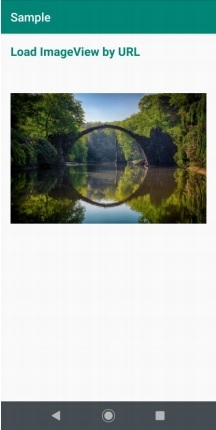
 Data Structure
Data Structure Networking
Networking RDBMS
RDBMS Operating System
Operating System Java
Java MS Excel
MS Excel iOS
iOS HTML
HTML CSS
CSS Android
Android Python
Python C Programming
C Programming C++
C++ C#
C# MongoDB
MongoDB MySQL
MySQL Javascript
Javascript PHP
PHP
- Selected Reading
- UPSC IAS Exams Notes
- Developer's Best Practices
- Questions and Answers
- Effective Resume Writing
- HR Interview Questions
- Computer Glossary
- Who is Who
How to load an ImageView by URL on Android using Picasso?
This example demonstrates about how do I load an ImageView on Android using Picasso.
Step 1 − Create a new project in Android Studio, go to File ⇒ New Project and fill all required details to create a new project.
Step 2 − Gradle Scripts from Project → Click build.gradle (Module: app) → add dependency − Implementation ‘com.squareup.picasso−Picasso:2.5.2 and click “Sync now”.
Step 3 − Add the following code to res/layout/activity_main.xml.
<?xml version="1.0" encoding="utf-8"?> <LinearLayout xmlns:android="http://schemas.android.com/apk/res/android" android:layout_width="match_parent" android:layout_height="match_parent" android:layout_margin="16dp" android:orientation="vertical"/> <TextView android:layout_width="wrap_content" android:layout_height="wrap_content" android:text="Load ImageView by URL" android:textStyle="bold" android:textColor="@color/colorPrimary" android:textSize="20sp" /> <ImageView android:id="@+id/image_view" android:layout_width="fill_parent" android:layout_height="300dp" android:layout_marginTop="16dp" /> <TextView android:layout_width="fill_parent" android:layout_height="match_parent" android:textSize="24sp" android:gravity="center|bottom" android:textStyle="bold" /> </LinearLayout>
Step 4 − Add the following code to src/MainActivity.java
import android.support.v7.app.AppCompatActivity;
import android.os.Bundle;
import android.widget.ImageView;
import com.squareup.picasso.Picasso;
public class MainActivity extends AppCompatActivity {
private ImageView imageView;
@Override
public void onCreate(Bundle savedInstanceState) {
super.onCreate(savedInstanceState);
setContentView(R.layout.activity_main);
ImageView imageView = findViewById(R.id.image_view);
String url = "https://images.pexels.com/photos/814499/pexels-photo814499.jpeg?auto=compress&cs=tinysrgb&dpr=1&w=500";
Picasso.with(this).load(url).into(imageView);
}
}
Step 5 − Add the following code to androidManifest.xml
<?xml version="1.0" encoding="utf-8"?> <manifest xmlns:android="http://schemas.android.com/apk/res/android" package="app.com.sample"> <uses-permission android:name="android.permission.INTERNET" /> <application android:allowBackup="true" android:icon="@mipmap/ic_launcher" android:label="@string/app_name" android:roundIcon="@mipmap/ic_launcher" android:supportsRtl="true" android:theme="@style/AppTheme"> <activity android:name=".MainActivity"> <intent-filter> <action android:name="android.intent.action.MAIN" /> <category android:name="android.intent.category.LAUNCHER" /> </intent-filter> </activity> </application> </manifest>
Let's try to run your application. I assume you have connected your actual Android Mobile device with your computer. To run the app from android studio, open one of your project's activity files and click Run ![]() icon from the toolbar. Select your mobile device as an option and then check your mobile device which will display your default screen −
icon from the toolbar. Select your mobile device as an option and then check your mobile device which will display your default screen −

Click here to download the project code.

